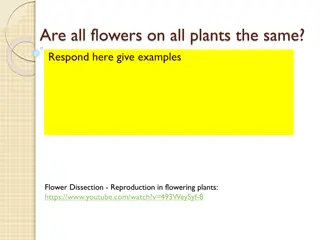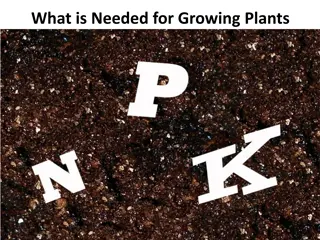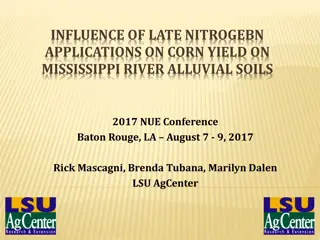Amino Acids: Disposal of Nitrogen
Overview of nitrogen metabolism with a focus on the disposal of nitrogen through amino acid catabolism. It explains the process of removing the α-amino groups from amino acids, the synthesis of urea, and the conversion of carbon skeletons to energy-producing pathways.
36 views • 65 slides
Energy Production
Explore different aspects of energy production and efficiency in thermal power plants, water heaters, coal-fired electrical generation plants, and natural gas electrical generation plants. Learn about energy density, mass calculations, overall efficiencies, and specific energy requirements in these
7 views • 57 slides
Understanding Nitrogen Fixation Process in Plants
Nitrogen fixation is the conversion of atmospheric nitrogen into ammonia or nitrates by bacteria or industrial processes for plant absorption. Biological and abiological methods exist, with various bacteria and cyanobacteria involved in the process. Symbiotic relationships between these organisms an
1 views • 10 slides
Understanding Flower Variations in Plants
Explore the diverse world of flowers in plants through examples and explanations of their reproductive parts and processes. Discover how some plants have both male and female flowers, while others have separate sex flowers. Learn about perfect flowers, the female and male parts of a flower, and the
0 views • 12 slides
Understanding Nitrogen Metabolism: Amino Acid Biosynthesis and Ammonia Incorporation
Nitrogen metabolism is crucial in the biosynthesis of amino acids such as glutamate and glutamine, incorporating ammonia for various physiological processes. Ammonia is efficiently transported and stored using compounds like alanine and glutamate, playing a key role in the urea cycle. Glutamate, a v
0 views • 22 slides
Understanding Thermal Power Plants: Overview and Operation
Thermal power plants play a crucial role in converting heat energy into electricity for various applications. This article covers the definition, layout, working principle, and components of thermal power plants, highlighting their advantages and top features. From converting heat into mechanical po
0 views • 20 slides
Understanding Transpiration and Gas Exchange in Plants
Transpiration is the evaporation of water from plants, mainly occurring through the leaves' stomata. Plants exchange gases like CO2 and O2 through various parts, without specialized organs. The process aids in photosynthesis, respiration, and cooling, demonstrating the importance of transpiration in
0 views • 22 slides
Nitrogen Fixation and Symbiotic Relationship in Agriculture
Nitrogen fixation is a crucial process where nitrogen is converted into ammonia by nitrogen-fixing bacteria, benefiting plants like legumes. Symbiotic nitrogen fixation involves a mutualistic exchange between plants and bacteria, exemplified by Rhizobium species. This symbiosis leads to the conversi
0 views • 15 slides
Conversion of Nitrogen Plants for Oxygen Generation in Medical Industry
CPCB has identified industries with nitrogen plants that can be converted to produce oxygen without impacting normal operations. Conversion involves using Zeolite Molecular Sieve and PSA technology, with M/s. UPL Ltd successfully converting a plant at LG Rotary Hospital in Gujarat within 72 hours. S
0 views • 15 slides
Understanding Transgenic Plants and Agrobacterium Tumefaciens in Plant Biotechnology
Creation of transgenic plants involves various methods such as microprojectile DNA-coating, electroporation, and Agrobacterium transformation. Agrobacterium tumefaciens, a soil bacterium, plays a crucial role in inducing crown gall disease in plants by transferring T-DNA from the Ti plasmid. The Ti
1 views • 27 slides
Understanding the Nitrogen Cycle and Erosion Process
Nitrogen, a vital element found in living and non-living things, plays a key role in the nitrogen cycle where it moves between organisms and the environment. However, human activities like using nitrogen-rich fertilizers can lead to environmental issues like waterway pollution. In addition, the proc
2 views • 6 slides
Understanding Nitrogen: Properties, Reactions, and Applications
Nitrogen, a colorless and odorless gas, is a vital element present in air and plays a crucial role in various chemical reactions. Known for its unreactive nature due to strong bonds, nitrogen is used in the manufacture of ammonia, fertilizers, and organic compounds. Discover how nitrogen is prepared
0 views • 43 slides
Understanding Poisonous Plants and Their Effects on Humans
Poisonous plants can have deleterious effects on individuals, leading to severe consequences and even death if not managed properly. These plants produce toxins that interfere with the body's essential functions, ultimately causing impairment and potential fatality. Recognizing the grades of poisoni
0 views • 11 slides
Surface Water-Groundwater Interactions and Nitrogen Cycling in a Tidally Influenced River Study
Study on the dynamic interactions between surface water and groundwater in a tidal river, focusing on nitrogen cycling. The research highlights the impact of tidal fluctuations on bank storage, nitrogen transformation, and nutrient cycling. Findings suggest that river discharge affects the exchange
1 views • 16 slides
Understanding Food Sources: Plants and Animals Explained
Food is essential for nourishing our bodies, and it comes from either plants or animals. Plants provide fruits, vegetables, grains, and more, while animals offer products like meat, milk, and eggs. Different parts of plants, such as roots, stems, and leaves, are consumed as food. Animals have varied
0 views • 11 slides
Maximizing Nitrogen Efficiency in In-Season Applications
This study explores the timing of in-season nitrogen applications in agriculture to optimize yield and minimize nitrogen loss. Results show that early application is crucial to reduce nitrogen loss susceptibility. The research includes key plant growth stages, such as physiological maturity and side
0 views • 30 slides
Understanding Nutrition in Plants and Their Relationship with the Environment
This educational content delves into the various modes of nutrition in plants, including heterotrophic and autotrophic nutrition, as well as saprotrophic and parasitic nutrition. It explains the process of photosynthesis, absorption of water through roots, oxygen production, and symbiotic relationsh
0 views • 13 slides
Evolution of N-Rich Strip Adoption in N Management
The adoption of N-Rich Strip has transformed nitrogen management practices over the years. Starting from small applications in 2003 to widespread utilization across acres in Oklahoma and Kansas, the confidence in this approach has grown significantly. Farmers are advised to monitor N-rich strips and
0 views • 17 slides
Mineral Absorption in Plants: Mechanisms and Types
Plants absorb minerals from the soil as ions through the roots, with the process of mineral absorption being distinct from water absorption. Mineral absorption in plants can occur through passive or active methods, each involving different mechanisms and energy requirements. Passive absorption is a
0 views • 14 slides
Asexual Reproduction in Plants: Methods and Examples
Asexual reproduction in plants, also known as vegetative propagation, involves various methods such as tubers, bulbs, and runners. It allows plants to reproduce without the involvement of sex cells and fertilization, resulting in genetically identical offspring. Artificial propagation techniques lik
0 views • 11 slides
Cover Crop Nitrogen Availability Calculator
Cover crops can impact nitrogen availability for cash crops. This calculator helps estimate nitrogen availability from cover crop biomass, guiding N management decisions. It requires data on cover crop biomass and composition. Positive values suggest a nitrogen credit, while negative values indicate
0 views • 7 slides
Understanding Photosensitization in Plants: Causes and Toxicity
Photosensitization in plants can lead to abnormal skin sensitivity to sunlight, caused by the presence of photodynamic agents in the skin and peripheral circulation. Primary and secondary photosensitization are common, with various plants and toxins contributing to liver damage and biliary occlusion
0 views • 12 slides
Systems-Oriented Concept Map Extension for Reactive Nitrogen Flows
International Organization for Chemical Sciences in Development presents a Systems-Oriented Concept Map Extension (SOCME) focusing on biogeochemical flows of reactive nitrogen from NH3. The concept explores core reaction subsystems, energy input subsystems, equilibrium conditions, and the integratio
0 views • 11 slides
Exploring the World of Plants: An Overview
Plants play a vital role in sustaining life on Earth by producing food and oxygen. This comprehensive guide delves into the diverse types of plants, such as herbs, shrubs, trees, creepers, and climbers. It also discusses the essential components of plants, like leaves, transpiration, and photosynthe
0 views • 20 slides
A Closer Look at Plants and Their Importance in Our Ecosystem
Plants play a vital role in our ecosystem, not only through photosynthesis but also in regulating atmospheric gases like oxygen and carbon dioxide. Understanding the definition of plants, from green algae to flowering plants, is essential. By studying plants, we uncover their critical contribution t
0 views • 12 slides
Effect of Microgravity on Nitrogen Fixation in Red Clover Study
Investigating the impact of microgravity on nitrogen fixation in red clover at Johnson County Central High School in Tecumseh, NE. The experiment aims to determine if clover exposed to space conditions fixates nitrogen similar to Earth conditions, crucial for growing food in space. Hypothesis, exper
0 views • 8 slides
Effect of Sulfur Fertilization on Nitrogen Use Efficiency for Spring Wheat and Corn
This research project, conducted by Dr. Jasper M. Teboh and his team at NDSU, investigates the impact of sulfur fertilization on nitrogen use efficiency for spring wheat and corn in Minnesota and North Dakota. The study aims to determine if wheat or corn respond to sulfur application, how sulfur aff
0 views • 25 slides
Understanding Plant Classification and Characteristics
Discover the classification of plants based on their structures and characteristics, including vascular vs. nonvascular plants, seed plants vs. seedless plants, and the definitions of angiosperms, gymnosperms, dicots, and monocots. Learn about the history of plant classification and how plants are g
0 views • 27 slides
Water Absorption by Plants: Mechanisms and Adaptation Strategies
Understanding water absorption by plants is crucial for effective water management in agriculture. Plants absorb water through active and passive methods, driven by osmotic and non-osmotic processes. Root hairs play a significant role in facilitating water uptake, with mechanisms such as osmotic act
0 views • 26 slides
Understanding Nitrogen Deficiency in Waterlogged Soils
Explore the impact of waterlogged soils on nitrogen deficiency in plants and discover the role of active transport, soil oxygen displacement, and chlorophyll production. Engage students in solving the issue through an interactive activity that integrates their knowledge of plant biology concepts.
0 views • 12 slides
Microbial Transformations of Nitrogen in Soil: Factors, Forms, and Impact on Plant Nutrition
Understanding the microbial transformations of nitrogen in soil is crucial for optimizing plant nutrition. Factors such as climate, water supply, cultivation, soil texture, and depth influence the nitrogen content in soil. The different forms of soil nitrogen, including inorganic and organic compoun
0 views • 23 slides
Understanding Abiotic Cycles in Ecosystems: Hydrologic, Carbon, Nitrogen, and More
Abiotic cycles play a crucial role in regulating ecosystems. The hydrologic cycle involves processes like evaporation, condensation, precipitation, and transpiration. The carbon cycle relies on photosynthesis, respiration, and human activities like deforestation and burning fossil fuels. The nitroge
0 views • 20 slides
The Role of Nitrogen in Plant Biochemistry: Understanding Nitrogen Metabolism
Nitrogen is a crucial element in plant biochemistry, essential for protein synthesis and the formation of various organic compounds. This article explores the sources of nitrogen available to plants, including atmospheric nitrogen, nitrates, and organic nitrogen compounds. The importance of nitrogen
0 views • 15 slides
Understanding Air Pollution Stress on Plants
The impact of air pollution on plants is a significant concern, affecting their physiology and overall health. Various air pollutants, such as sulfur dioxide, ozone, and nitrogen compounds, have been identified as phytotoxic agents, leading to severe or subtle effects on plant life. Detecting the ef
0 views • 21 slides
Nitrogen-Doped Carbon Nanotubes for Hydrogen Storage
Hydrogen is a promising energy carrier for the future, and efficient storage under ambient conditions is a key challenge. Nitrogen-doped carbon nanotubes show potential due to their unique structure and chemical properties. This study focuses on the facile synthesis and hydrogen storage application
0 views • 12 slides
Rice GHG Emissions under Varied Nitrogen, Variety, and Water Management Study in Arkansas
Detailed study on rice greenhouse gas emissions under varied nitrogen, variety, and water management treatments, focusing on nitrogen fertility, crop varieties, and water usage impact on methane and nitrous oxide emissions. Research examines optimal nitrogen rates for reduced global warming potentia
1 views • 18 slides
Factors Influencing Algae Growth in Water Ecosystems
Nutrients play a crucial role in algae growth, with inorganic nutrients like nitrogen and phosphorus being key factors. Algae require macroelements such as carbon, hydrogen, oxygen, sulfur, potassium, calcium, phosphorus, and nitrogen in large quantities, as well as microelements like iron, manganes
0 views • 16 slides
The Essentials of Plant Nutrition: Nitrogen, Phosphorus, and Potassium
Plants require a balanced diet of nutrients for growth and development. Nitrogen stimulates above-ground growth, phosphorus enhances root growth and flower formation, while potassium promotes fruit development. However, excessive use of fertilizers can lead to environmental issues like algal blooms,
0 views • 6 slides
Influence of Late Nitrogen Applications on Corn Yield on Mississippi River Alluvial Soils - 2017 NUE Conference
Excessive rainfall in the lower Mississippi Delta can lead to late-season nitrogen deficiency in corn crops. Research conducted at the LSU AgCenter focused on evaluating the efficacy of supplemental nitrogen at late growth stages on Mississippi River alluvial soils. Field experiments from 2006 to 20
0 views • 19 slides
Plant Classification and Reproduction Overview
Plants are categorized into four groups: Mosses, Ferns, Conifers, and Flowering Plants. Mosses reproduce by spores and lack roots or xylem vessels. Ferns reproduce via spores, while conifers reproduce with seeds found in cones and have needle-shaped leaves. Flowering plants reproduce using seeds fou
0 views • 8 slides







































